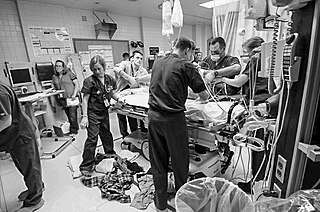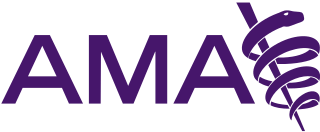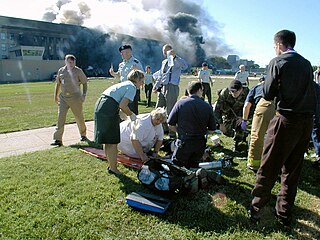Medical psychology or medico-psychology is the application of psychological principles to the practice of medicine, sometimes using drugs for both physical and mental disorders.

A physician, medical practitioner, medical doctor, or simply doctor is a health professional who practices medicine, which is concerned with promoting, maintaining or restoring health through the study, diagnosis, prognosis and treatment of disease, injury, and other physical and mental impairments. Physicians may focus their practice on certain disease categories, types of patients, and methods of treatment—known as specialities—or they may assume responsibility for the provision of continuing and comprehensive medical care to individuals, families, and communities—known as general practice. Medical practice properly requires both a detailed knowledge of the academic disciplines, such as anatomy and physiology, underlying diseases, and their treatment, which is the science of medicine, and a decent competence in its applied practice, which is the art or craft of the profession.

Emergency medicine is the medical speciality concerned with the care of illnesses or injuries requiring immediate medical attention. Emergency medicine physicians specialize in providing care for unscheduled and undifferentiated patients of all ages. As first-line providers, in coordination with emergency medical services, they are primarily responsible for initiating resuscitation and stabilization and performing the initial investigations and interventions necessary to diagnose and treat illnesses or injuries in the acute phase. Emergency medical physicians generally practice in hospital emergency departments, pre-hospital settings via emergency medical services, and intensive care units. Still, they may also work in primary care settings such as urgent care clinics.

A general practitioner (GP) or family physician is a doctor who is a consultant in general practice.

The American Medical Association (AMA) is an American professional association and lobbying group of physicians and medical students. Founded in 1847, it is headquartered in Chicago, Illinois. Membership was 271,660 in 2022.
International emergency medicine is a subspecialty of emergency medicine that focuses not only on the global practice of emergency medicine but also on efforts to promote the growth of emergency care as a branch of medicine throughout the world. The term international emergency medicine generally refers to the transfer of skills and knowledge—including knowledge of ambulance operations and other aspects of prehospital care—from developed emergency medical systems (EMSs) to those systems which are less developed. However, this definition has been criticized as oxymoronic, given the international nature of medicine and the number of physicians working internationally. From this point of view, international emergency medicine is better described as the training required for and the reality of practicing the specialty outside of one's native country.

The American College of Emergency Physicians (ACEP) is a professional organization of emergency medicine physicians in the United States. ACEP publishes the Annals of Emergency Medicine and the Journal of the American College of Emergency Physicians Open.

Family medicine is a medical specialty within primary care that provides continuing and comprehensive health care for the individual and family across all ages, genders, diseases, and parts of the body. The specialist, who is usually a primary care physician, is named a family physician. It is often referred to as general practice and a practitioner as a general practitioner. Historically, their role was once performed by any doctor with qualifications from a medical school and who works in the community. However, since the 1950s, family medicine / general practice has become a specialty in its own right, with specific training requirements tailored to each country. The names of the specialty emphasize its holistic nature and/or its roots in the family. It is based on knowledge of the patient in the context of the family and the community, focusing on disease prevention and health promotion. According to the World Organization of Family Doctors (WONCA), the aim of family medicine is "promoting personal, comprehensive and continuing care for the individual in the context of the family and the community". The issues of values underlying this practice are usually known as primary care ethics.
A medical specialty is a branch of medical practice that is focused on a defined group of patients, diseases, skills, or philosophy. Examples include those branches of medicine that deal exclusively with children (paediatrics), cancer (oncology), laboratory medicine (pathology), or primary care. After completing medical school or other basic training, physicians or surgeons and other clinicians usually further their medical education in a specific specialty of medicine by completing a multiple-year residency to become a specialist.
Adolescent medicine, also known as adolescent and young adult medicine, is a medical subspecialty that focuses on care of patients who are in the adolescent period of development. This period begins at puberty and lasts until growth has stopped, at which time adulthood begins. Typically, patients in this age range will be in the last years of middle school up until college graduation. In developed nations, the psychosocial period of adolescence is extended both by an earlier start, as the onset of puberty begins earlier, and a later end, as patients require more years of education or training before they reach economic independence from their parents.
Disaster medicine as a specialty and mindset was not only a reaction from September 11, 2001, but to the numerous subsequent events that seemed to all too quickly follow: random anthrax attacks, the SARS outbreak, the New York City blackout in the summer of 2003, the December 26, 2004 Indian Ocean earthquake and tsunami, the Pakistan earthquake of 2005, tumultuous hurricane seasons in 2004 and 2005 and, of course, terrorist attacks throughout the world — all against a backdrop of conflict in Afghanistan and Iraq.
The medical establishment in North America and the United Kingdom began forming study and discussion groups in disaster medicine. In some cases, the medical schools were on the front lines of this movement. Meanwhile, courses and fellowships in disaster medicine related fields at universities in London, Paris, Brussels, Bordeaux and the United States have been in existence since the early 1980s.
Throughout this period, incomplete and faltering medical responses to disaster events made it increasingly apparent that federal, state and local emergency management organizations were in need of a mechanism to identify qualified physicians in the face of a global upturn in the rate of natural and man-made disasters. Many physicians who volunteer at disasters have a bare minimum of knowledge in disaster medicine and often pose a hazard to themselves and the response effort because they have little or no field response training. It was against this backdrop that the American Academy of Disaster Medicine (AADM) and the American Board of Disaster Medicine (ABODM) were formed for the purpose of scholarly exchange and education in Disaster Medicine as well as the development of an examination demonstrating excellence towards Board Certification in this new specialty.
Board certification is the process by which a physician or other professional demonstrates a mastery of advanced knowledge and skills through written, oral, practical, or simulator-based testing.
The American Board of Physician Specialties (ABPS), the official certifying body for the American Association of Physician Specialists (AAPS) is a non-profit umbrella organization for sixteen medical specialty boards that certifies and re-certifies physicians in fourteen medical specialties in the United States and Canada. It is one of three certifying bodies in the United States in addition to the American Board of Medical Specialties, and American Osteopathic Association Bureau of Osteopathic Specialists. The ABPS oversees Doctor of Medicine (M.D.) and Doctor of Osteopathic Medicine (D.O.) certification in the United States. The ABPS assists its Member Boards in developing and implementing educational and professional standards to evaluate and certify physician specialists. It is recognized by the U.S. Department of Labor as well as the Centers for Medicare and Medicaid Services (CMS).
The American Association of Physician Specialists, Inc. (AAPS) is a 501(c)(6) not-for-profit organization founded in 1950, with headquarters in Tampa, Florida.
Established in 1939, the American Osteopathic Association's (AOA) Bureau of Osteopathic Specialists (BOS) is the supervisory body for the AOA's 16 Specialty Certifying Boards in the United States. The BOS establishes and enforces policy for board certification through the AOA Specialty Certifying Boards and maintains high standards for certification through the development and implementation of educational and professional standards used to evaluate and certify osteopathic and non-osteopathic physician.

Disaster medicine is the area of medical specialization serving the dual areas of providing health care to disaster survivors and providing medically related disaster preparation, disaster planning, disaster response and disaster recovery leadership throughout the disaster life cycle. Disaster medicine specialists provide insight, guidance and expertise on the principles and practice of medicine both in the disaster impact area and healthcare evacuation receiving facilities to emergency management professionals, hospitals, healthcare facilities, communities and governments. The disaster medicine specialist is the liaison between and partner to the medical contingency planner, the emergency management professional, the incident command system, government and policy makers.
In 2006, hospice and palliative medicine was officially recognized by the American Board of Medical Specialties, and is co-sponsored by the American Boards of

Physicians are an important part of health care in the United States. The vast majority of physicians in the US have a Doctor of Medicine (MD) degree, though some have a Doctor of Osteopathic Medicine (DO), or Bachelor of Medicine, Bachelor of Surgery (MBBS).

The International Federation for Emergency Medicine (IFEM) is an organisation promoting international emergency medicine around the world. It is a consortium of over 70 national and regional emergency medicine organisations. IFEM organises the International Conference on Emergency Medicine (ICEM).
Frederick M. "Skip" Burkle, Jr. is an American physician known for his work in human rights, international diplomacy and peacemaking, humanitarian assistance, and disaster response. He has been called "the single most talented and experienced post-conflict health specialist working for the United States government." His medical qualifications include pediatrics, emergency medicine, psychiatry, public health, and tropical medicine.








